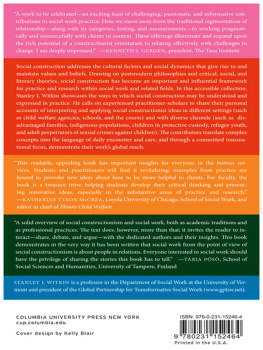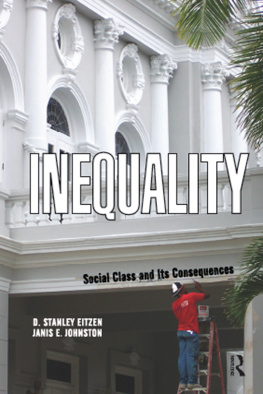COLUMBIA UNIVERSITY PRESS
Publishers Since 1893
New York Chichester, West Sussex
cup.columbia.edu
Copyright 2014 Columbia University Press
All rights reserved
E-ISBN 978-0-231-53762-9
Leslie Is Different, words and music by Fred Small 1983 Pine Barrens Music (BMI), from the Rounder album No Limit (www.rounder.com).
Library of Congress Cataloging-in-Publication Data
Narrating social work through autoethnography / edited by Stanley L Witkin.
pages cm
Includes bibliographical references and index.
ISBN 978-0-231-15880-0 (cloth : alk. paper) ISBN 978-0-231-15881-7 (pbk. : alk. paper)
ISBN 978-0-231-53762-9 (e-book)
1. Social serviceResearch. 2. Social servicePractice. 3. Social workers. 4. Ethnosociology. 5. Autobiography. 6. Narrative inquiry (Research method) I. Witkin, Stanley L, 1947
HV11.2.N37 2014
361.301dc23
2013040523
A Columbia University Press E-book.
CUP would be pleased to hear about your reading experience with this e-book at .
Cover design: Lisa Hamm
Cover image: plainpicture/B. Jaubert
References to websites (URLs) were accurate at the time of writing. Neither the author nor Columbia University Press is responsible for URLs that may have expired or changed since the manuscript was prepared.
I MET STANLEY WITKIN IN 1988 at a meeting of the Group for the Advancement of Doctoral Education in Social Work. Stan was there as a Ph.D. program director and I as a member of the Task Force on Social Work Research, sponsored by the National Institute of Mental Health. The meeting would serve as the official launch of the task force. As we walked and talked, I realized that Stan and I shared the aim of making social work research and its recognized knowledge more consistent with the fields historical values of deep respect for people and their self-determination. This was a time of heady progress for those academics working to make social work a research-based profession. Achieving that status would mean sharing resources, status, and hierarchical organization with the biomedical professions supported by the big federal institutes. My own outlook on social work knowledge and research, which I attribute largely to the strong dialectical quality of my undergraduate education in Chapel Hill, was consciously critical, always trying to find the flaws and possibilities for whatever was presented as knowledge. Stan was clarifying his position as a social constructionist. He was already showing evidence of the proverbial innovatorhe was ahead of the pack, with arrows in his back.
In the end, my work on the task force to advance the aims I shared with Stan proved to be something of a fools errand. The mainstream version of science prevailed on the highest tiers of the social work scaffolds. But there was also a lot more going on. There was a strong but less visible alliance of talented, mindful social workers whose energy and ideas led to the book you are reading now. Few knew what to call these pioneersconstructionists, new-paradigm advocates, postmodernists, or humanists; they were a growing chorus of increasingly compelling social work voices advocating recognition of broader ways of understanding people and their experience of life, as mediated by culture. The core of their argument was that the field must recognize the views and enhance the influence of the purported beneficiaries of social work, as well as clarifying and strengthening the voices of practicing social workers.
Throughout their history, social workers have inhabited a contentious profession, debating, for example, whether to emphasize social causes versus social functions, the value of Freudian versus Rankian practice, or whether the field was deprofessionalizing itself or advancing itself with the bachelor of social work degree. The positivist versus social constructionist debate of recent years is also a part of that history. Out of the vigorous disagreements, limited accommodation has occurred. Means of expression and communication have broadened, and now there is a much wider recognition of the legitimacy of knowledge found and portrayed in a social constructionist frame. Even many of the federal funders now advocate including qualitative and quantitative perspectives in some research projects, a small but significant step in the peace process. History is not just what happened; it is also where we are now. The publication of this book is proof.
A popular aphorism states that Social workers have a front-row seat at the drama of human existence. And indeed social workers do get to learn firsthand about some of the most extraordinary aspects of the human condition. At the same time, social workers live in the midst of a social movement to make the records of these experiences as concrete as possible. Our professional culture rests on the idea, whether carefully enacted or fudged in practice, that we must know the hard facts or measurable dimensions and diagnoses of almost every situation, whether we are conducting a child-protection investigation, charting eligibility for assisted living accommodations, or figuring out what might occur in a community. The overarching model assumes that we must count how often something undesirable occurs or something desirable does not occur before we get too involved, in order to count again later, once we have been involved, to see how much things have changed. Managers and auditors may assign financial terms to each element of the equation, and the result often dictates the all-important bottom line. For the practitioner, this metamodel almost always involves assuming a role (putting on a performance) dictated by some authority, regardless of whether they believe in the value of the model. But the social workers prized seat at the human drama is wasted unless the social worker goes beyond this surface layer of observations. It is essential to carry observations into realms of memory, context, imagination, and the shared experience of relationship. This book offers accounts that serve as exemplars for ways to seek deeper understanding of both the self and the other. Autoethnographies such as these, and the ones that social workers help clients and communities develop daily, not only describe what was and is, they pull us into what happened and what is happening, here and now, and they make us authors of the future, whatever it confronts us with.

 COLUMBIA UNIVERSITY PRESS NEW YORK
COLUMBIA UNIVERSITY PRESS NEW YORK








